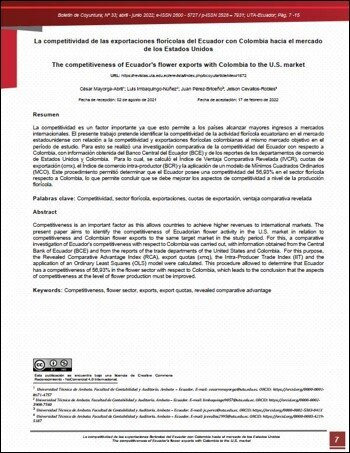The competitiveness of Ecuador's flower exports with Colombia to the U.S. market
Main Article Content
Abstract
Competitiveness is an important factor as this allows countries to achieve higher revenues to international markets. The present paper aims to identify the competitiveness of Ecuadorian flower activity in the U.S. market in relation to competitiveness and Colombian flower exports to the same target market in the study period. For this, a comparative investigation of Ecuador's competitiveness with respect to Colombia was carried out, with information obtained from the Central Bank of Ecuador (BCE) and from the reports of the trade departments of the United States and Colombia. For this purpose, the Revealed Comparative Advantage Index (RCA), export quotas (xmq), the Intra-Producer Trade Index (IIT) and the application of an Ordinary Least Squares (OLS) model were calculated. This procedure allowed to determine that Ecuador has a competitiveness of 56,93% in the flower sector with respect to Colombia, which leads to the conclusion that the aspects of competitiveness at the level of flower production must be improved.
URL: https://revistas.uta.edu.ec/erevista/index.php/bcoyu/article/view/1672
Downloads
Article Details

This work is licensed under a Creative Commons Attribution-NonCommercial 4.0 International License.
![]()
The publications of the Boletín de Coyuntura are licensed under a Creative Commons Attribution-NonCommercial 4.0 International License (CC BY-NC 4.0). The Universidad Técnica de Ambato retains the copyright of the published works, and favors and allows the reuse of these, as long as: the authorship and original source of publication is cited, and they are not used for commercial or onerous purposes. The intellectual property of the published articles belongs to the authors.
References
Ahcar Olmos, J., Delgado Arias, D., & Peláez Soto, J. (2019). Oportunidades de exportación del Valle del Cauca en el acuerdo comercial Colombia-Canadá: el Caso del sector azucarero. Economía & Región, 5(2), 131-153. Obtenido de https://revistas.utb.edu.co/index.php/economiayregion/article/view/249
Alonso Rodríguez, J. A. (1999). Comercio internacional : de las ventajas comparativas a las ventajas competitivas. Revista Asturiana de Economía, 129-148.
Álvarez Herranz, A., Barraza, S., & Legato, A. (2009). Inversión Extranjera Directa y Crecimiento Económico en Latinoamérica. Información Tecnológica, 20(6), 115-124. doi:10.1612/inf.tecnol.4116it.08
Aval. (2021). Situación financiera actualizada del sector florícola. Quito: Información general del empresas. Obtenido de https://www.aval.ec/informacion-general-de-empresas/situacion-financiera-actualizada-del-sector-floricola/
Balkyte, A., & Tvaronaviciene, M. (2010). Perception of competitiveness in the context of Sustainable Development: Facets of "Sustainable Competitiveness". Journal of Business Economics and Management, 341-365. doi:10.3846/jbem.2010.17
Banco Central del Ecuador. (2019). Boletín anuario 2018. Quito: Banco Cenmtral del Ecuador. Obtenido de https://www.bce.fin.ec/index.php/component/k2/item/327-ver-bolet%C3%ADn-anuario-por-a%C3%B1os
Camino Mogro, S., Andrade Díaz, V., & Pesántez Villacís, D. (2016). Posicionamiento y eficiencia del banano, cacao y flores del Ecuador en el mercado mundial. Ciencia UNEMI, 9(19), 48-53. Obtenido de http://ojs.unemi.edu.ec/index.php/cienciaunemi/article/view/323/279
Campi, I., Font, M., & Lascano, C. (2017). La competitividad en América Latina, el caso Ecuador. Dimensión Empresarial, XV(29). Recuperado el 18 de Junio de 2021, de https://dialnet.unirioja.es/servlet/articulo?codigo=6068517
Capobianco-Uriarte, M. d., Casado-Belmonte, M. d., Marín-Carrillo, G. M., & Terán-Yépez, E. (2019). A Bibliometric Analysis of International Competitiveness (1983–2017). SUSTAINABILITY. doi:10.3390/su11071877
Durán Lima, J., & Alvarez, M. (2008). Indicadores de comercio exterior y política comercial: mediciones de posición y dinamismo comercial. CEPAL – Colección Documentos de proyectos, 5-41. Obtenido de https://repositorio.cepal.org/bitstream/handle/11362/3690/1/S2008794_es.pdf
El Universo. (1 de Noviembre de 2020). $ 24 millones al año en aranceles dejarán de pagar exportaciones de rosas ecuatorianas a Estados Unidos. Guayaquil, Ecuador. Obtenido de https://www.eluniverso.com/noticias/2020/10/31/nota/8033716/rosas-cero-aranceles-exportacion-eeuu-acuerdo-comercial-1-noviembre/
Expoflores. (2019). Informe Anual de Exportaciones. Quito: Expoflores. Obtenido de https://expoflores.com/wp-content/uploads/2020/04/reporte-anual_Ecuador_2019.pdf
Garcés Cano, J. E. (2015). Revisión crítica de los postulados clásicos del comercio internacional: un ejercicio empírico sobre Colombia y Perú. Finanzas, Política y Economía, 7(1), 147-168. doi:http://dx.doi.org/10.14718/revfinanzpolitecon.2015.7.1.8
García Hernández, B. J. (2010). Visión hacia la Cultura de Exportaciones de los empresarios de las PyMES del Estado de Hidalgo y su impacto en el. VII Congreso de la AMET, 1-24.
García Luna, R., & Maldonado Atencio, A. (2013). Competitividad del calzado de cuero colombiano: perspectiva de la ventaja comparativa revelada. Dimensión Empresarial, 11(1), 77-91. doi:https://doi.org/10.15665/rde.v11i1.162
Gomez, M. (2011). El impacto del sistema de preferencias arancelarias andinas y la erradicación de la droga (ATPDEA) sobre el sector floricultor ecuatoriano. Quito: Pontificia Universidad Católica del Ecuador.
Huesca Rodríguez, C. (2012). Comercio internacional (Primera ed.). México D.F.: Red Tercer Milenio. doi:978-607-733-004-2
Labarca, N. (2007). Consideraciones teóricas de la competitividad empresarial. Omnia, 158-184. Obtenido de http://www.redalyc.org/articulo.oa?id=73713208
Nadalipour, Z., Khoshkhoo, M. H., & Eftekhari, A. R. (2019). An integrated model of destination sustainable competitiveness. Competitiveness Review, 314-335. doi:10.1108/CR-12-2017-0086
Orozco, M. (2007). Entre la competitividad local y lacompetitividad global: floricultura comercial en el Estado de México. Convergencia, XIV(45), 111-160. Recuperado el 19 de Junio de 2021, de http://www.scielo.org.mx/scielo.php?script=sci_arttext&pid=S1405-14352007000300006&lng=es&nrm=iso
Salazar Cantú, J. (2007). Estructura y evolución reciente de las ventajas comparativas de México y de sus estados. Trayectorias, 67-88. Obtenido de http://www.redalyc.org/articulo.oa?id=60735446003
U.S. International Trade Commission. (2003). Cut Flowers. (D. T. Chairman, & J. Vice Chairman, Edits.) Industry & trade sumary(3580), 45. Obtenido de https://www.usitc.gov/publications/332/pub3580.pdf
Vanegas López, J. G., Merlos García, J., & Mayorga Abril, C. M. (2017). Flower Export Barriers: A Comparative Study in Colombia, Mexico and Ecuador. Latin American Business Review, 1-25. doi:10.1080/10978526.2017.1354705
Verdugo Morales, N., & Andrade Díaz, V. (2018). Productos tradicionales y no tradicionales del Ecuador: Posicionamiento y eficiencia en el mercado internacional para el período 2013-2017. X-pedientes Económicos, 2(3), 84-102. Obtenido de https://www.academia.edu/40445715/Productos_tradicionales_y_no_tradicionales_Ecuador
Villamar Ortíz, D. P., Paccha Soto, M. d., Ruso León, J. A., & Moreira Macías, M. F. (2018). Decisions of the atpdea and its impact on the floriculture. Comparative case Colombia-Ecuador. 2011-2015. INNOVA RESEARCH JOURNAL, 3(7), 136-146. doi:10.33890/innova.v3.n7.2018.608


